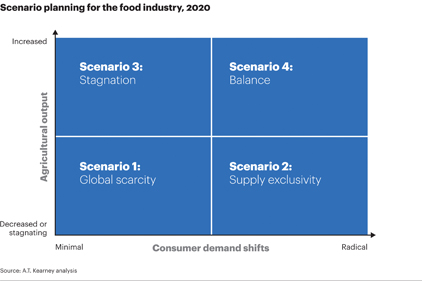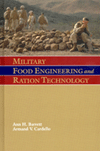
|
| A.T. Kearney envisions four potential scenarios for the food industry's future. |
With the global population exploding, weather patterns in flux and commodity prices racing up, food companies will need to adapt to new models to survive—and thrive—in the next decade.
The world population reached 7 billion in 2012, and developing economies grew at a torrid 6.3 percent annually between 2000 and 2010. The most obvious impact of this increase in worldwide wealth has been the growth of a global middle class. In 2000, China had just 3 million households with disposable income over $10,000. It now has nearly 60 million such households, and will have 230 million by 2020.
How will the global food markets of the future react to such intense population and wealth growth? A new study from A.T. Kearney offers four possible scenarios for the future of food, each in response to hypothetical increases or decreases in agricultural output and minimal or radical shifts in consumer demand.
The first scenario results from decreased output and minimal shifts in demand. In this scenario, current trends continue to create larger global wealth disparities, supply shocks are common and prices are unstable.
Scenario two would result from radical demand shifts but decreased production, and envisions an economy dominated by supply exclusivity. This dynamic would see companies compete not on the basis of price or quality but on assured supply continuity, and the effectiveness of global networks determined by the ability of food companies to meet global demand.
In scenario three, the current supply and demand dynamic—where demand slightly exceeds supply, but not enough to create a panic—persists, leading to stagnation. A.T. Kearney says this scenario would result from increased production and minimal shifts in consumer demand.
Only the fourth scenario, wherein governments and companies balance supply and demand in a flexible, equitable and predictable manner, achieves equilibrium. That scenario would result from increased agricultural output and radical changes in consumer demand.
According to the study, new market dynamics will cause faster innovation cycles, industry consolidation and competition between supply networks rather than individual companies.
Social media, emerging information technologies and the onward march of globalization will ensure that tastes change even more quickly and over a broader geographical scope. The study says current strategies and R&D organizations aren’t oriented to respond with sufficient speed and cost effectiveness, and they must adapt with faster innovation cycles.
Such rapid shifts in consumer demand combined with a constrained supply base will increase interdependence among partners in the supply chain. According to the study, food companies will have to augment network management skills as competition shifts from individual companies to supply chains.
Along with this shift in the dynamic of competition, global scale will be increasingly important to meet demand in emerging markets and secure access to inadequate resources. The companies best able to take advantage of their scale and influence on the global market will adapt best to changing opportunities in the face of population growth, shifting diets and restricted availability of agricultural commodities.





